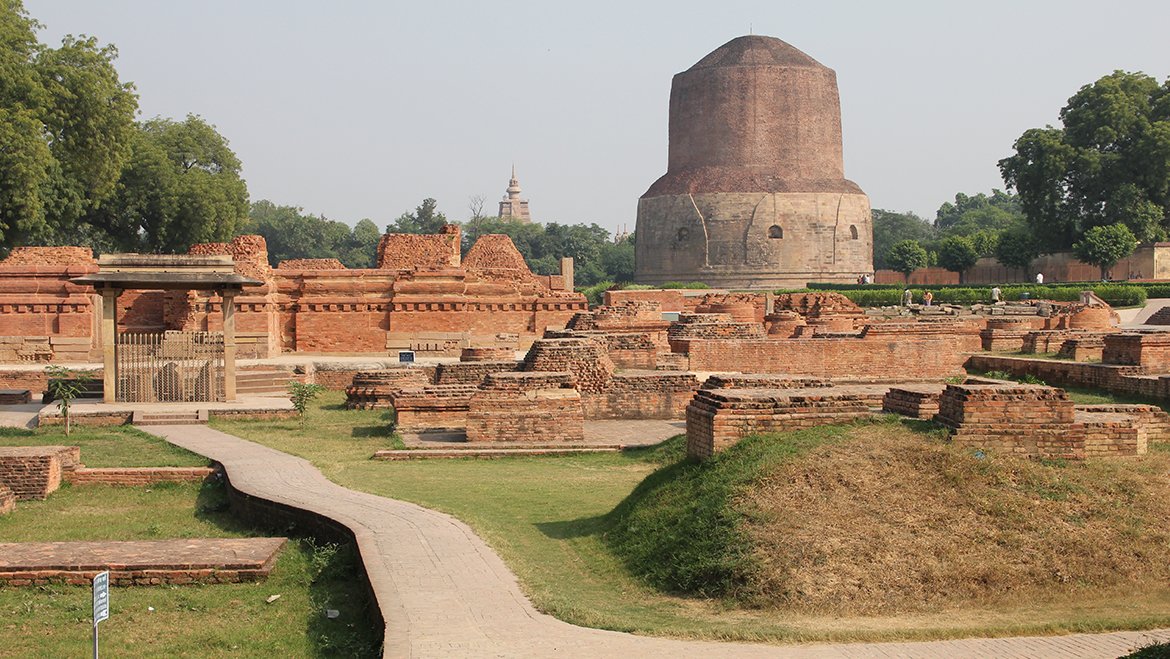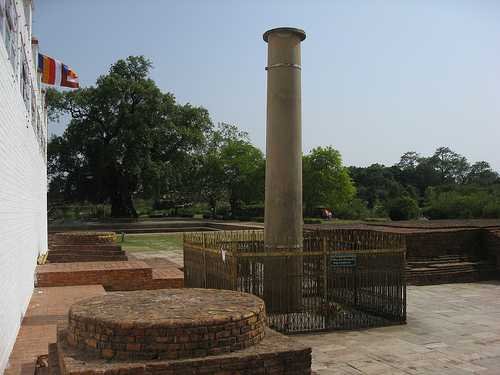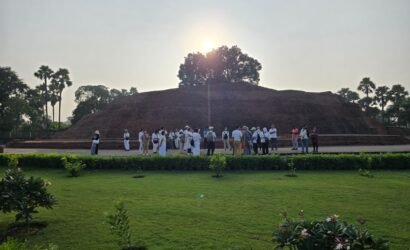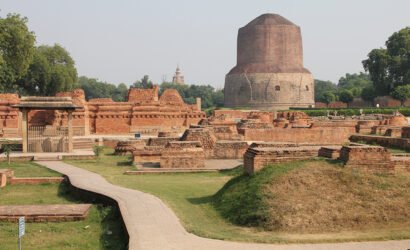
Itinerary
Day 1 :
Gaya
Mahabodhi Temple, Bodh Gaya The Mahabodhi temple, also called the "Great Awakening Temple", is a UNESCO World Heritage Site located in Bodhgaya, Bihar. It is a Buddhist temple that marks the location where the Lord Buddha is said to have attained enlightenment. Lord Buddha holds a very significant place in the religious history of India as he is believed to be the 9th and the most recent incarnation of Lord Vishnu to have walked the earth. The temple spreads over an area of a whopping 4.8 hectares and is 55 meters tall Great Buddha Statue, Bodh Gaya Overview This statue of Lord Buddha is the tallest in India and was instated by the XIV Dalai Lama in 1989. It is a meditating Buddha resting on a giant lotus, constructed using intricately carved sandstone and red granite. Tibetan Refugee Market, Bodh Gaya Overview This market is paradise for shopping lover. It offers a large variety of winter-wears, handicrafts and souvenirs, etc. Bodhi Tree, Bodh Gaya Overview The Bodhi Tree, located 100 kilometres to the south of Patna in the north Indian state of Bihar, is perhaps the most prominent and respected sacred places in Buddhism because of the rich historical significance attached to it. It is under this tree that Prince Siddhartha Gautama, the spiritual teacher who later became to be known as the Buddha, attained enlightenment. It is believed that Prince Siddhartha had to sit and meditate under this tree for seven days. Later on, a shrine known as Animisalocana Cetiya was erected on the spot where he had sat down. A small temple was also built near the Bodhi tree in the 7th century.
Day 2 :
Varanasi
Varanasi, Banaras or Kashi, call it what you will, the city where many come to find god, spirituality or simply themselves is a gamut of life. Situated in Uttar Pradesh, Varanasi is one of the oldest continuously inhabited cities in the world. Boat ride at the Ganges Varanasi is synonymous with the river Ganga. The old city of sages, gurus, travelers and traders begins and ends with the sacred river. Some say that just sitting at the ghats and observing people from different walks of life teaches you many things. It is also exhilarating to take a quiet boat ride at the crack of dawn and watch as the city turns into the chaotic bustle that it is. Eat Apple Pie in Vatika Cafe A lot of people come to Varanasi to experience spirituality and find the meaning of life. One foolproof way to finding happiness, though, is eating an apple pie at Vatika café overlooking the river Ganga. As you bite into the hot piece of pie while a cool breeze softly brushes your face, life will make more sense! Eat Apple Pie in Vatika Cafe A lot of people come to Varanasi to experience spirituality and find the meaning of life. One foolproof way to finding happiness, though, is eating an apple pie at Vatika café overlooking the river Ganga. As you bite into the hot piece of pie while a cool breeze softly brushes your face, life will make more sense!
Day 3 :
Khusinagar
Kushinagar is a holy place which is based on great historic and spiritual significance. It was crowned as an esteemed pilgrimage center of the Buddhists which is located in the Kushinagar district of Uttar Pradesh. Tourists from every corner of the globe come here in search of peace. Kushinagar has numerous stupas (a heap like structure holding Buddhist remnants, once thought to be places of Buddhist worship, typically the remains of a saint) and viharas (a vihara is an Indian Buddhist monastery),which are almost finished but still have their own charm and importance in the life of the people. Most of these structures ruined in the period between the 3rd and the 5th centuries. The Muktabandhana Stupa is considered the most important destination in Kushinagar which houses the last cremated remains of Lord Buddha. It has a beautiful idol of Lord Buddha which is carved by a monk and restored by king Haribala during the period of 413-455 A.D. There are two striking temples: the Nirvana temple and the Mathakaut temple. It is placed near the Nirvana temple where Lord Buddha breathed his last. It is located at Khushinagar where one can see a black stone image of Lord Buddha during excavations. The Wat Thai temple is one of the major attractions of Kushinagar, which is built in a typical Thai-Buddhist architectural style.
Day 4 :
Lumbini
Ashoka Pillar, Lumbini Overview The Ashoka Pillar in Lumbini is one of the 3rd Century stone pillars built under the reign of Emperor Ashoka. It was erected as a mark of respect by Ashoka after he visited Lord Buddha's place of birth and decided to accept Buddhism. These facts make the pillar a significantly important attraction in the country. Bodhi Tree, Lumbini Overview The Bodhi Tree in Lumbini is located in the divine premises of the Maya Devi Temple complex right next to the vibrant shrine on the banks of the serene Maya Devi Pond. It is considered highly sacred in the region and worshipped with great devotion. One may visit the tree after exploring the temple before maybe sitting by the pond admiring the tranquillity of the site. Mayadevi Pond, Lumbini Overview Located right in front of the Maya Devi temple in Lumbini, Maya Devi Pond is quite a simple yet attractive square shaped structure with steps all around to ascend to the water level. Also known as Puskarini, this is where Gautama Buddha's mother - Maya Devi - used to bathe. Cambodian Monastery, Lumbini Overview Cambodian Monastery in Lumbini is an amalgamation of colorful fantasy and spiritual forces making it one of the most fascinating temples in the region. Built in a architectural design matching the famous Angkor Wat, the charming monastery is surrounded by a square railing, each having four 50m green snakes. The large compound has an outer wall covered with beautiful and intricate designs. Royal Thai Buddhist Monastery, Lumbini Overview Royal Thai Monastery in Lumbini is an imposing and stunning wat-style monastery dedicated to Buddhist practises. The gleaming building is constructed from white marble and the blue-roofed meditation center are example of a fine architectural style. The beautiful designs and carving on the temple wall makes this place a must-visit.
Day 5 :
Srasvasti
Sravasti has been identified with the remains at Saheth-Maheth, situated on the banks of the river Rapti. It was the capital of ancient Kosala kingdom and is sacred to the Buddhists because it is here that Lord Buddha performed the greatest of his miracles to confound the Tirthika heretics. These miracles include Buddha creating multiple images of himself, which has been a favourite theme of Buddhist art. It is well-connected with good roads constructed under Buddhist-Circuit. 1. About 15km from Bahraich lies this sprawling complex of Buddhist stupas and ruins, believed to be founded by the mythological king Sravast, the town played host to Buddha for 27 years and was his annual rainy season retreat. 2. It was the capital of the ancient Koshal empire and here the Buddha showed his divine prowess to impress upon the non-believers. 3. The excellently-preserved ruins have a meditative air around them and amid them stands an ancient Bodhi Vriksh (tree). 4.The huge World Peace Bell in Sravasti established with Japanese help, is said to convey the message of humanity through its toll.
Day 6 :
Lucknow
Bara Imambara, Lucknow Overview The Bara Imambara of Lucknow is one of the most famous monuments of the city. Also known as Asfi Imambara, after the name of the Nawab of Lucknow who got it constructed, it is an important place of worship for the Muslims who come here every year to celebrate the religious festival of Muharram. The Imambara is primarily known for its incredible maze, known as Bhul Bhulaiya locally, which is located on the upper floor of the monument. Hazratganj Market, Lucknow Overview Hazratganj, the central shopping district of Lucknow, has a long history behind it and has undergone a great makeover that bridges the past and the present and continues to serve as Lucknow's central shopping arcade. Lucknow Zoo, Lucknow Overview Located in the heart of Lucknow, the Lucknow Zoo, also known as the Nawab Wazid Ali Shah Prani Udyan, is a favourite among wildlife enthusiasts from all over the city. This massive zoo is spread over an area of 71.6 acres and was established in the year 1921 to commemorate the visit of His Royal Highness, the Prince of Wales to Lucknow.






